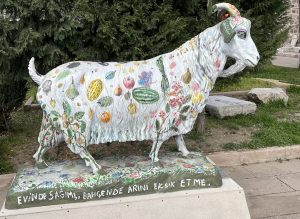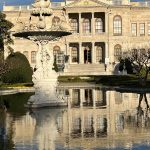Ankara’s blockbuster attraction is the Anatolian Civilisations Museum (open daily, admission TL280) which houses the finds from many hugely important Central Anatolian sites such as Çatal Höyük, Gordion and Alaca Höyük. It’s housed in an attractive double-domed bedesten (market hall) commissioned by Mahmut Paşa, a grand vizier to Sultan Mehmet II, and once housed 102 shops. Tacked onto it is the Kurşunlu Han built by another of Mehmet’s grand viziers. Both buildings were abandoned after a fire in 1881 and Atatürk suggested that they be restored as a museum shortly before his death in 1938. The first part of the museum opened in 1943, the remainder in 1968. It sits in an attractive garden on the slope leading up to the Hisar (Kale) with a great view down over the city.
There have been mutterings about moving the museum to a new site which would be a great shame. However, the labelling and lighting of the current exhibits could certainly do with some updating.
Inside the museum
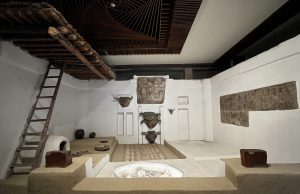 A room from Çatal Höyük
A room from Çatal Höyük
The majority of the exhibits are laid out in chronological sequence around the perimeter of the building with the largest stone pieces from sites such as Carchemish in the long central hall.
As you turn right from the entrance you’ll come first to the Paleolithic (Old Stone Age) finds. At the far end of the section a room from Çatal Höyük has been reconstructed to suggest how life would have been lived in Central Anatolia 8,000 years ago. Nearby stand replicas of two of the T-bar carved pillars more recently excavated at Göbeklitepe, near Şanlıurfa. Once you turn the corner you will find, on the right-hand wall, some of the incredible frescoes found at Çatal Höyük, many of them depicting wild animals such as leopards. The fresco once thought to show the last eruption of Hasan Dağı no longer seems to be interpreted that way now.
Near the frescoes can be seen the particularly roly-poly figurine that has given rise to much talk of a goddess cult at Çatal Höyük. She is certainly impressive in her own right but another case nearby shows that many other statuettes of fleshy women in all sorts of poses have also come to light there.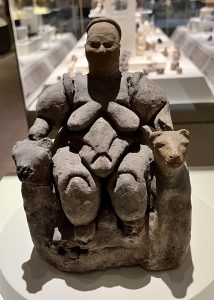
The exhibits then segue into the Chalcolithic period especially as it has been interpreted from the sites of Hacılar and Canhasan, which yielded some very impressive red-glazed pots. Fom Tilkitepe came a large collection of obsidian tools with the obsidian probably sourced from Nemrut Dağı or Süphan Dağı on the shores of Lake Van.
Next come finds from what is called the Halaf culture which covered most of Mesopotamia but was particularly important in Turkey at Carchemish, Sakce Gözü and Domuztepe, near Kahramanmaraş. A diorama shows men making iron before the exhibits home in on the finds from the Hatti and Hittite sites at Alaca Höyük and Bögazköy/Hattuşa in particular. The sun discs and deer statuettes are some of the most striking exhibits in the museum. Not surprisingly one of the finest has become the symbol of Ankara. From the Bronze Age the museum displays finds from less well-known sites such as Beycesultan, Karataş Semayük, Horoztepe, Karaoğlan and Karayavşan. It then homes in on what is called the Assyrian Trading Colonies period with many cuneiform tablets discovered at Kültepe, near Kayseri, on show. Here, too, are cuneiform tablets and seals found in the royal archives at Hattuşa.  It’s towards the end of the outer section that you come to some more of the most striking exhibits which include Phrygian finds from Gordion and magnificent Urartian metalwork from around Lake Van; the wooden table and screen from Gordion are particularly impressive. Here, too, there is a copy of what one of the huge Phrygian monuments at Midas Şehri would have looked like in the days when a statue of the goddess Kybele sat inside a niche there. There is also an amazing reconstruction of a tiled wall from the Phrygian site at Pazarlı, near Çorum. Close by is a huge basalt cube with almost undamaged carvings of gods astride wild animals that came from Adilcevaz on the northern shore of Lake Van.
It’s towards the end of the outer section that you come to some more of the most striking exhibits which include Phrygian finds from Gordion and magnificent Urartian metalwork from around Lake Van; the wooden table and screen from Gordion are particularly impressive. Here, too, there is a copy of what one of the huge Phrygian monuments at Midas Şehri would have looked like in the days when a statue of the goddess Kybele sat inside a niche there. There is also an amazing reconstruction of a tiled wall from the Phrygian site at Pazarlı, near Çorum. Close by is a huge basalt cube with almost undamaged carvings of gods astride wild animals that came from Adilcevaz on the northern shore of Lake Van.
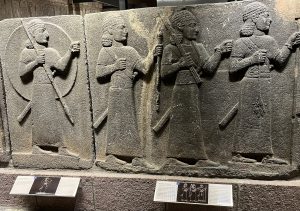 The inner hall
The inner hall
The inner hall of the museum is ringed with magnificent orthostats that lined the edges of buildings at Carchemish. Others come from Aslantepe, near Malatya, and from the less well- known site at Salçagözü.
Here, too, are the huge sphinx statues that once guarded the entrance to the palace at Alaca Höyük. 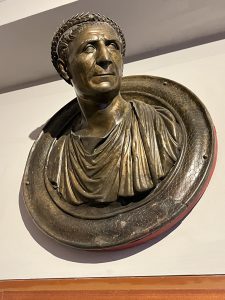
The basement
Don’t overlook the stairs leading down to the basement where finds from Ankara itself are on display. Here you can see what excavations at the Roman baths and theatre uncovered, for example.
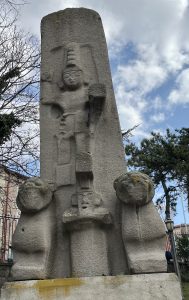 The garden
The garden
It’s worth taking a turn round the garden which contains some interesting finds, most of them from the Classical period. Most striking is the replica of a stela that lies in a quarry on the hillside at Fasıllar, near Beyşehir in the Turkish Lake District.
At the back near the shop a group of painted goats recall the animal whose fur once helped make Ankara rich.
Amenities
The museum has a cafe and shop in the garden as well as a small shop inside the main building. Holders of Turkish müzekarts qualify for discounts on their purchases so check before paying. 